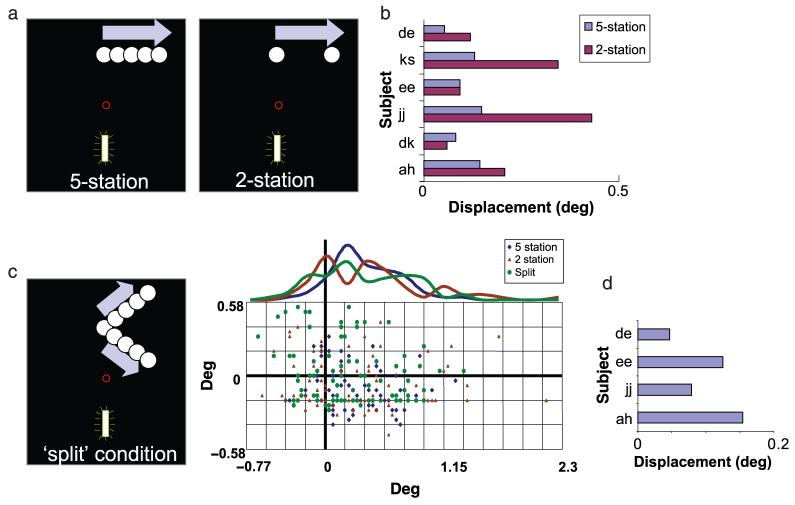Figure 2.
The FLE is explained by motion signals biasing localization judgments. (a) Observers reported whether the starting position of a moving dot (1° above fixation) was to the right or to the left of a flashed bar (1° below fixation). The first dot and the flash appear simultaneously on a dark screen. In the five-station apparent-motion condition (left), the moving dot occupied five positions over 67 ms; in the two-station condition (right), the dot moved the same distance in the same time with no visibility in the second to fourth positions. Starting position, direction, and condition were randomized. Dot diameter = 0.5°, bar height = 0.5°, bar width = 0.1°. (b) Fifty percent of the psychometric function was determined as the measure of perceived offset for each observer. Observers perceived the moving dot to be ahead of the flash by 0.11° ± 0.04° (five-station condition) and 0.21° ± 0.15° (two-station condition). n = 6. (c) Again, observers watch a flash appear simultaneously with the first position of a moving dot. In this experiment, they click (with no time pressure) anywhere on the screen to indicate the perceived position of the first dot. The split condition is the same as the five-station condition (above), but here, the first dot splits into two trajectories ±45° to the horizontal. The five-station and two-station conditions were randomly interleaved with this condition, and direction of motion was randomized. Localization of the first dot is biased by the sum of motion vectors, as indicated by the distribution of mouse clicks normalized to a single direction of motion. The distributions in the three conditions are each significantly different from zero (p < .008, two-tailed t test) and not significantly different from one another in pairwise comparisons (all p values > .24). n = 6 observers, 40 trials each. (d) Frohlich effect. Stimulus was the same as the five-station condition in Panel a, except that the flashed bar was replaced by a continuously present bar (a “landmark”). Observers indicated whether the first visible position of the moving object was to the right or to the left of the landmark. Average offset = 0.1° ± 0.05°.

